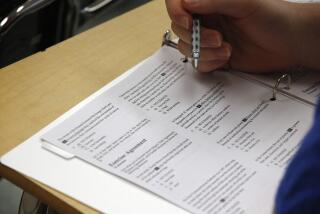After first try, put the pencil down
- Share via
After sophomore Anthony Mainero finished filling in the last ovals on the PSAT exam Wednesday morning in the airy gymnasium of the Sage Hill School in Newport Coast, he contemplated what the test symbolized -- the start of the college admissions roller coaster.
Over the next two years, the 15-year-old plans to focus on standardized tests, high-level coursework, enriching summer classes and free-time activities that make his applications to such places as Yale and Stanford universities and the U.S. Military Academy at West Point rise above the competition.
“Colleges want super-high scores on the SAT, they want you to have practically perfect grades, and they want you to do all these extracurriculars,” said Mainero, who took the PSAT for the fourth time Wednesday. He took the test three times previously as part of a UC Irvine program for high-achieving students.
“Where do you draw the line? As much as you want to get into all these schools, is it worth it to kill yourselves over it?” he said.
Mainero is among the more than 3 million students across the nation who took the PSAT Wednesday or will take it Saturday. The test, which receives far less attention than other pre-college assessments such as the SAT, is viewed by guidance counselors and college admissions officials as a vital step on students’ paths to college. And for the students who achieve the highest scores, doing well on the PSAT can lead to tens of thousands of dollars in scholarships -- in this year’s freshman class at USC, 140 students each received nearly $18,000 in annual scholarships from the university based largely on their PSAT scores.
Some families are placing so much value on the exam that they are increasingly sending their children to pricey test-preparation courses, despite schools’ admonishments against it and despite the fact that no college admissions official will ever see the scores.
“The main importance of the PSAT is really to give students a dry run before they take the SAT,” said Heather Keddie, director of college counseling at Sage Hill, a private school. “Colleges and universities don’t generally see the students’ PSAT scores. . . Its main benefit is giving them the chance to take it without all the pressure of knowing all the scores are sent to colleges.”
Students are given two hours and 10 minutes to complete the five-section exam that tests their knowledge of reading, writing and math. Although the PSAT is shorter than the SAT, it is conducted in a similar format, in large group settings where students are strictly timed and are limited to bringing sharpened pencils and calculators. Students must take the PSAT during their junior year to qualify for recognition and college scholarships from the National Merit Scholarship Corp., but many also take it during their sophomore year for practice and some even as freshmen.
The Los Angeles Unified School District, for the third year, paid for all of its sophomores to take the exam Wednesday.
“It helps open students’ eyes regarding the option of college,” said Roni Parker, director of secondary college career counseling for the district, which decided to hold testing on Wednesday instead of Saturday so that more students would participate. “It had a lot to do with the recognition of the PSAT being a gateway to college, and the idea it’s such a useful tool. Students who take the PSAT tend to do better on the SAT. . . and learn their strengths and weaknesses from the score reports.”
Parker estimated that about 45,000 L.A. Unified sophomores took the exam Wednesday, as well as many juniors and freshmen. They will receive college informational brochures in the mail and can access online college-planning tools.
At the Francisco Bravo Medical Magnet High School in Los Angeles, students said the greatest benefit was being able to practice their test-taking skills before they take the SAT during their junior and senior years.
“Timing was definitely a big issue,” said sophomore Vicky Krutikova. “I felt like there wasn’t enough time. By the time I finished reading a section, I would barely have enough time left to answer questions.”
To prepare to take the PSAT again next year, and the SAT after that, the 15-year-old -- who hopes to attend UCLA or UC Berkeley -- said she plans on taking timed practice tests and reviewing her vocabulary and math skills.
Tsovinar Karapetyan said she might seek tutoring to prepare for the test before taking it again.
“It was very stressful, very nerve wracking,” said the 15-year-old sophomore who hopes to attend USC and become a pediatrician.
With the high-pressure nature of the college admissions process, students are increasingly taking test-prep courses for the PSAT and taking the test more frequently.
“Parents have a real strong desire to make sure their kids are not put at a disadvantage in any way. People feel they are not doing enough for their child, which I think is wrong but I understand the emotion,” said Keddie of Sage Hill.
“Test prep is big business and I think a lot of our students do it. We urge them to take the PSAT and the SAT one time before going into any kind of test prep, and we suggest they do [test prep] in the summer before their senior year so it doesn’t interfere with classes or having an actual life.”
Timothy Brunold, director of admissions at USC, is more forthright about taking the PSAT.
“I think it’s absurd for students to take that more than once,” he said. “The advice I give students is don’t make a career out of taking these exams. It’s counterproductive and really not what admissions officers are interested in seeing,” he said. “I’d much rather a student be engaged in some meaningful activity” instead of spending their time “prepping for these exams or taking multiple sittings of the exams.”
--
(BEGIN TEXT OF INFOBOX)
Sample questions
Students are given two hours and 10 minutes to complete the PSAT, a standardized exam traditionally taken during junior year to help them prepare for the SAT and qualify for recognition and college scholarships. The test is divided into five parts: two 25-minute critical reading sections, two 25-minute math sections and one 30-minute writing skills section.
Test your high-school knowledge on some sample questions:
1. Sentence completion
(Fill in the blank with the best option listed below.)
A discerning publishing agent can ------- promising material from a mass of submissions, separating the good from the bad.
(A) supplant
(B) dramatize
(C) finagle
(D) winnow
(E) overhaul
2. Math multiple choice
If y = (x + 3)2, then (-2x - 6)2 must equal which of the following?
(A) -4y2
(B) -2y2
(C) -4y
(D) 2y
(E) 4y
3. Improving sentences
(Replace the italicized phrase with the best option listed below.)
Hearing that the Statue of Liberty did not have a pedestal, a campaign was begun by Joseph Pulitzer to raise money for the construction of one.
(A) a campaign was begun by Joseph Pulitzer to raise money
(B) a campaign to raise money was initiated by Joseph Pulitzer
(C) money was raised in a campaign by Joseph Pulitzer
(D) Joseph Pulitzer began a campaign to raise money
(E) Joseph Pulitzer had campaigned to raise money
Answers
1. D
2. E
3. D
Source: The College Board
More to Read
Sign up for Essential California
The most important California stories and recommendations in your inbox every morning.
You may occasionally receive promotional content from the Los Angeles Times.











